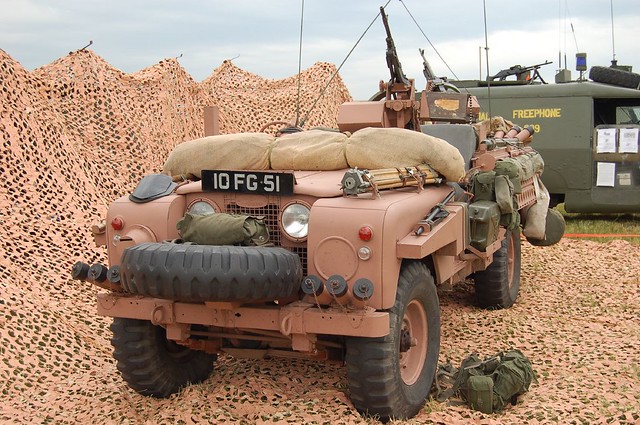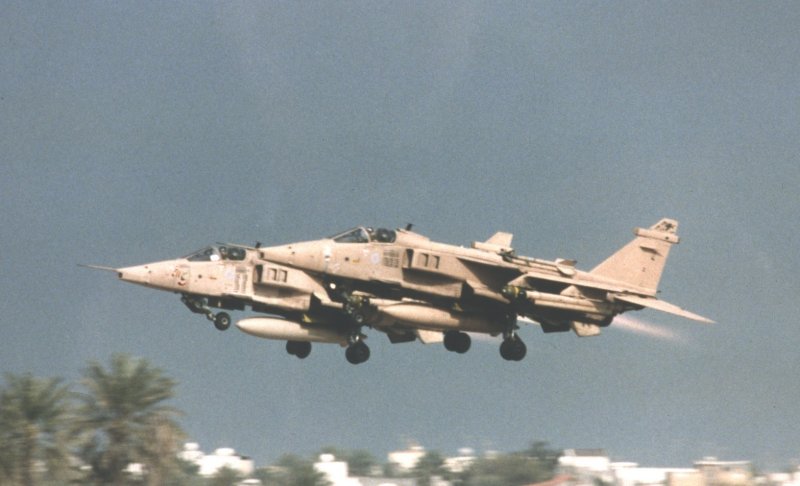|
|
Post by Cybermortis on Jan 22, 2013 15:22:15 GMT
I've run across the myth that during WW2 British special forces used pink camouflage as this worked better at night. Now my brief searches have only come up with fashion clothing for women, and this en.wikipedia.org/wiki/Mountbatten_pinkI was wondering if anyone has heard of this type of camouflage, or anything similar? |
|
|
|
Post by rmc on Jan 22, 2013 15:31:11 GMT
Yes, Cyber! I think that wiki details what the original viewer was trying to ask about (although I have no idea why they titled it S.A.S. pink). Perhaps they were just trying to sound military-familiar?
|
|
|
|
Post by the light works on Jan 22, 2013 16:02:11 GMT
|
|
|
|
Post by Lokifan on Jan 22, 2013 16:47:23 GMT
I wonder if they could do an episode on all camouflage myths?
Another one: Colorblind people can spot camouflage better than non-colorblind people.
|
|
|
|
Post by the light works on Jan 22, 2013 16:51:23 GMT
I wonder if they could do an episode on all camouflage myths? Another one: Colorblind people can spot camouflage better than non-colorblind people. I would think that would relate more to more practice with shape recognition than the actual colorblindness. or to put it differently, the greater the degree of colorblindness, the more things are naturally camouflaged. |
|
|
|
Post by freegan on Jan 22, 2013 20:53:56 GMT
I've run across the myth that during WW2 British special forces used pink camouflage as this worked better at night. Now my brief searches have only come up with fashion clothing for women, and this en.wikipedia.org/wiki/Mountbatten_pinkI was wondering if anyone has heard of this type of camouflage, or anything similar? The legend that I heard has it that, during WWII, a British day-time desert reconnaissance patrol almost collided with an unnoticed downed civilian aircraft in the desert that had been stripped of its paintwork, to the pinkish primer coat, by sandstorms. The lack of contrast with the surrounding desert had prevented its discovery by search aircraft before the war and its subsequent discovery by the patrol gave the later SAS the idea for their Pink Panther.  |
|
|
|
Post by Cybermortis on Jan 22, 2013 23:11:48 GMT
Superb freegan, just the sort of information I was looking for.  |
|
|
|
Post by User Unavailable on Feb 6, 2013 5:34:35 GMT
We had a quite extensive thread on this topic on the old Disco site, full of links and pics, that were found by various members. A shame that it is all gone now. www.eliteukforces.info/special-air-service/mobility-troop/sas-land-rover/Google images has several good pics of "SAS pink Land Rovers". As the link above states the pink land rovers came about in the 1960s I have read on various discussion forums that the SAS and Long Range Desert Group experimented with pink jeeps in WWII, but have never seen a source other than hearsay on a forum back that up. Cyber, to your original question, here is a link that may interest you.. It talks briefly about Mountbatten pink further down the page and has some pics of other ship camo schemes. (It doesn't really appear to be a military oriented site, so take from it what you will) www.darkroastedblend.com/2007/11/modernist-art-in-camouflage.html |
|
bioLarzen
Demi-Minion
   "I reject your avatars and substitute my own."
"I reject your avatars and substitute my own."
Posts: 86
|
Post by bioLarzen on Feb 13, 2013 14:00:50 GMT
I've run across the myth that during WW2 British special forces used pink camouflage as this worked better at night. Now my brief searches have only come up with fashion clothing for women, and this en.wikipedia.org/wiki/Mountbatten_pinkI was wondering if anyone has heard of this type of camouflage, or anything similar? just using the mountbatten + camouflage keyword combo in google yielded quite some relevant hits, so, by all probability, this color was indeed used as camouflage - the hits mostly mention vehicles. BTW, I would hardly call this color pink on my own... but maybe that's just me. bio |
|
bioLarzen
Demi-Minion
   "I reject your avatars and substitute my own."
"I reject your avatars and substitute my own."
Posts: 86
|
Post by bioLarzen on Feb 13, 2013 14:02:37 GMT
I know how this color works as a camouflage: the guard guy looks in his binoculars, sees a pink ship or tank in the distance. WTF? A PINK battleship? A PINK tank? I must be hallucinating... And so he doesn't report it  Psychological warefare at its best  bio |
|
|
|
Post by Cybermortis on Feb 13, 2013 14:10:45 GMT
This seems to be very similar to the 'Dazzle' camouflage scheme, in that it was clearly used but neither appears to have been tested to see if it was effective.
Well, no one who knew Mountbatten would have called him a good seaman either. A contemporary quipped that if it was possible to leave skid marks on water, the North Sea would have been criss-crossed with the marks left from the ships Mountbatten commanded.
|
|
|
|
Post by privatepaddy on Feb 13, 2013 16:50:13 GMT
This seems to be very similar to the 'Dazzle' camouflage scheme, in that it was clearly used but neither appears to have been tested to see if it was effective. Well, no one who knew Mountbatten would have called him a good seaman either. A contemporary quipped that if it was possible to leave skid marks on water, the North Sea would have been criss-crossed with the marks left from the ships Mountbatten commanded. According to the link you Provide Lord Louis observed a ship still painted in its pre-war colours being hard to see at around dawn and dusk and adapted it to come up with a colour that would make a ship less vulnerable at that time where ships could be silhouetted against a horizon . I would not call "pink". It had its draw backs but looking at in and having stood watches prior to dawn I can see how it might have worked. Indeed it is "credited" with some measure of success in the operation named which the British Cruiser HMS Kenya took place. As for Razzel Dazzel there was nothing wrong with the myth, just the proposed development of it. |
|
|
|
Post by the light works on Feb 13, 2013 16:58:54 GMT
I am wondering if people are missing the point that the "pink" was used in a specific environment - just as modern camouflage doctrine is based on using camouflage patterns appropriate to the area they are used in. you don't see many desert camo HMMWVs being deployed to arctic environments.
|
|
|
|
Post by User Unavailable on Feb 14, 2013 5:04:48 GMT
I am wondering if people are missing the point that the "pink" was used in a specific environment - just as modern camouflage doctrine is based on using camouflage patterns appropriate to the area they are used in. you don't see many desert camo HMMWVs being deployed to arctic environments. Correct. "Pink" was for specific environments/conditions. While some types of camo are designed to be useful across a wider variety of conditions/environments, some very narrow in there application. I.e. Snow Overwhites. |
|
|
|
Post by silverdragon on Feb 14, 2013 7:12:55 GMT
 This is the paint scheme for "Desert Storm" Jaguars..... In Action....  |
|
|
|
Post by oldcodger on Feb 17, 2013 2:55:46 GMT
Some PRU Spitfires were painted a light pink for the same reason that the RN painted their warships pink.
|
|
|
|
Post by Cybermortis on Feb 17, 2013 17:31:34 GMT
Some PRU Spitfires were painted a light pink for the same reason that the RN painted their warships pink. I'd forgotten about the reconnaissance version of the Spitfire. Something my 14 year old self would never forgive himself for doing. |
|
|
|
Post by oldcodger on Feb 17, 2013 21:08:24 GMT
The funny thing about the pink Spits...while the pink camouflage was effective the pilots hated flying missions in them. They felt that the pink color would attract every Luftwaffe fighter in the air.
|
|
|
|
Post by Cybermortis on Feb 21, 2013 22:52:07 GMT
I'm not sure why, but I *think* that the pink camouflage scheme used on RAF aircraft was in fact tested - unlike the similar schemes used on ships. Thinking about this it would make sense, since it would be quite easy and fairly cheap to paint an aircraft - Spitfires being some 30 ft long, 36 ft wide (that is wingspan) and standing some 11 ft tall. A small Destroyer was some 320 ft long and 32 ft wide in comparison.
|
|
|
|
Post by silverdragon on Feb 25, 2013 9:04:18 GMT
The aircraft tested were "Flown over" by other aircraft whilst on the ground... not as easy to spot.
In sand terrain and other scorched earth, in low flying scenario's, it also blends in quite nicely....
Its a matter of comparison.
Take the usual green brown black tan sort of camouflage used on military stuff, put that in a desert, if you cant spot it standing out like a sore thumb, try spec-savers?....
"Pink" sandy colours blend in a lot better........
|
|